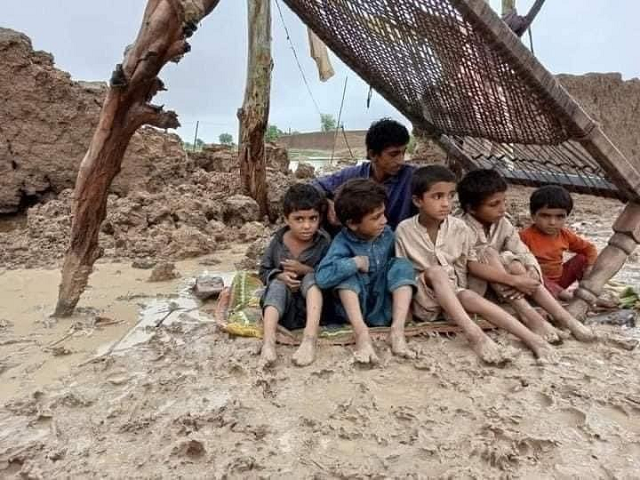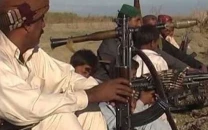Pakistan declares emergency amid catastrophic floods
Govt appeals to citizens' 'national spirit' to come forward and help in providing relief to affected people

Describing the devastating floods as “a national emergency”, the government on Thursday appealed to the “national spirit” of the people to come forward and extend their helping hand for the relief of the marooned people, as more aid flew in from friendly countries.
The enormity of the monstrous floods was increasing with each passing day, with the death toll and the number of marooned people escalating at a rapid pace. The National Disaster Management Authority (NDMA) put the nationwide death toll from the rains and floods at 937.
According to the latest data, the floods have wreaked havoc in 116 of the country’s 160 districts, which roughly translates into three-fourths of the country. Overall, the NDMA said 4,254,740 people were affected by the floods, including 215,997 people living in relief camps.
“This is a national emergency and we will have to treat it as such,” Climate Change Minister Sherry Rehman told a press conference in Islamabad, echoing an earlier statement of Information Minister Marriyum Aurangzeb, who also declared the flood situation as a national emergency.
Both Rehman and Aurangzeb stressed that the government was doing its best to provide relief to people but a lack of resources was a major problem. “The federal government is making great efforts together with the provinces and resources are being mobilised,” Aurangzeb said.
“Due to the large-scale disaster, a huge amount of money will be required,” Aurangzeb said, adding that the entire nation, especially the overseas Pakistanis, were urged to send donations. “The people in distress are waiting for our help. Let's all support each other.”
The information minister said that local and overseas Pakistanis could deposit donations in the Prime Minister Relief Fund with Account # G-12164. The overseas Pakistanis could also send donations through wire transfer, money service bureaus, money transfer operators and exchange houses, she added.
Providing some figures of the damages, so far, Rehman said 20 million people were rendered homeless or without shelter. “This is a very big figure,” she said, adding that devastating monsoon season was “very rare” and unexpected. This is a “climate-induced humanitarian disaster of epic proportions”, she said.
Aurangzeb said that Prime Minister Shehbaz Sharif chaired an international partners meeting for cooperation in flood rescue, relief, rehabilitation after reaching Islamabad from his Qatar visit. She added that Shehbaz would visit Sukkur on Friday (today) to review rescue and relief activities.
The monsoon season runs from July through September in Pakistan. This year monsoon and pre-monsoon rains broke 30-year record in Pakistan and the NDMA data shows that 30-year average rain was 131 millimetres but the rainfall in 2022 season was 375.4 mm – 187% more.
Infrastructure damaged in Balochistan
According to the NDMA data, floods from June 14-24, partially and fully damaged 670,328 houses, 3,082 kilometres of roads, 145 bridges and killed 793,995 livestock animals across Pakistan, besides washing away businesses and other infrastructure. The worst affected provinces are Sindh and Balochistan.
Read Floods wreak untold havoc as death toll tops 900
In Balochistan, the continued heavy rainfall paralysed life in 26 districts of the province for second consecutive day on Thursday. Since most parts of Balochistan were already flooded, the recent rainfall further aggravated the situation.
Quetta, Killa Abdullah, Pishin, Lasbela, Naseerabad, Mastung, Barkhan and other parts of Balochistan received heavy rainfall for more than 24 hours. The rains and floods had severed Balochistan’s railway link to the rest of the country as well as other communication links.
Heavy rainfall severely affected pedestrian movement at the Pakistan-Afghan border crossing in Chaman. Videos shared on social media showed people passing the border after it was completely flooded.
The floods also damaged the Sui Southern Gas Company pipeline in Bolan area, suspending gas supply to various parts of Quetta, Pishin, Kalat, Mastung and Ziarat. The power supply from 220 KV transmission line from Sibi to Quetta was also snapped.
“Floods damaged the 140 year old railway bridge in Bolan area of Balochistan,” Kachhi Deputy Commissioner Imran Bangulzai told The Express Tribune. Bangulzai added that floods damaged the Bibi Nani Bridge, suspending the traffic on the Quetta-Sibi highway.
Officials said that landslide in Dana Sar area of Khyber-Pakhtunkhwa also caused suspension of traffic between Quetta and Islamabad. All passenger trains remained halted at Sibi and Jacobabad railway stations because of the flooding of the tracks, Muhammad Izharul Haq, a railway official said.
12 die in K-P
At least 12 people died as flash floods hit Swat, Tank, Dera Ismail Khan, Lakki Marwat and Dir Upper districts, the Provincial Disaster Management Authority (PDMA) said. It added that most of the fatalities occurred because of roof collapse incidents. At least three houses were destroyed and eight damaged.
A PDMA official said that four people were killed in Lower Kohistan flash floods; two women were killed in Lakki Marwat and one in Dir Lower, a child died in Buner and two women died when the vehicle they were travelling in from Balochistan to Chitral was swept away by flash flood in Upper Dir.
According to the PDMA official, a 20-year-old man drowned in the Swat river in the Fatah Pur area of Swat district. Due to the flood in Swat River, all the buildings located along the river have been vacated. The authorities have also closed down all schools in the district for two days.
Tent cities in Sindh
Sindh decided on Thursday to establish tent cities at the union council level to shelter the marooned people, while army troops from Corps V joined the efforts of the district administrations to distribute ration bags and other materials to the affected masses.
Sindh Chief Minister Murad Ali Shah chaired a rain emergency and relief meeting. The meeting decided that the district administrations would use diesel engines and electricity to pump out the floodwaters from the cities and towns, as the already flooded canals and branches were unable to drain any water.
It was also decided that the government would constitute district-level committees to start relief, rescue, and survey and damages assessment operations at the Deh level. The committees would comprise the deputy commissioner concerned and representatives from Corps-V, engineering Corps, PDMA and locals.
“Comparatively, the embankments of our rivers are in a better condition than the flood situation of 2010 and 2011, but various vulnerable points are still under pressure,” Shah told the meeting. “If the mountain range of Punjab received more rains, the flow in the river would increase, thereby exerting more pressure on the bunds,” he added.
(WITH INPUTS FROM OUR QUETTA CORRESPONDENT SYED ALI SHAH, PESHAWAR CORRESPONDENT MUHAMMAD HAROON AND KARACHI CORRESPONDENT HAFEEZ TUNIO)


















COMMENTS
Comments are moderated and generally will be posted if they are on-topic and not abusive.
For more information, please see our Comments FAQ